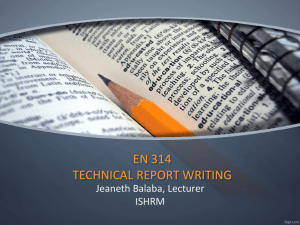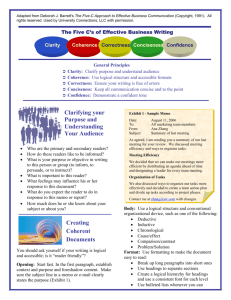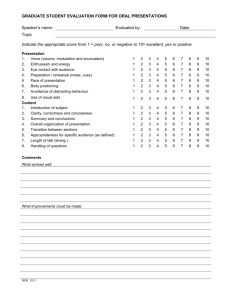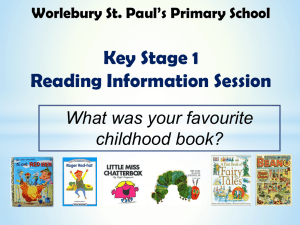Essentials of Good Writing
advertisement
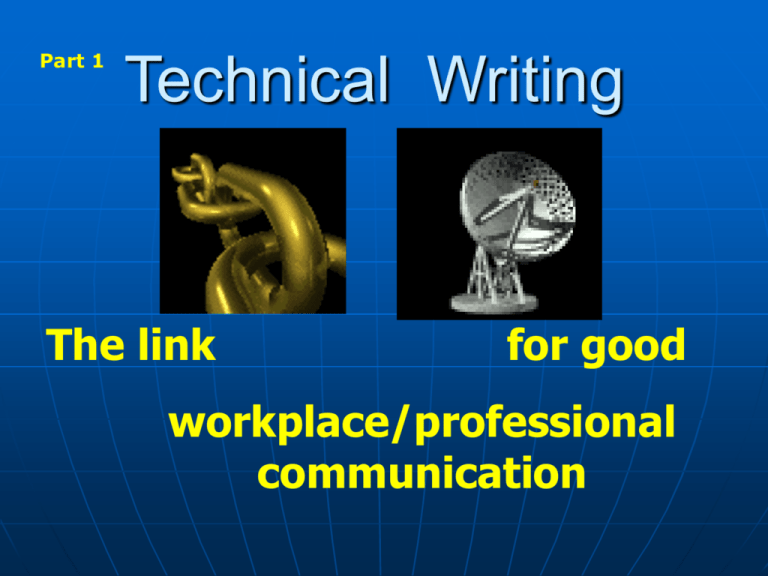
Part 1 Technical Writing The link for good workplace/professional communication “Technical” or “Business” writing is very different from “Academic” writing. Each has its unique purpose and format to follow. Technical writing is done in the workplace and centers around technical topics. Technical writing has unique characteristics and has specific audiences. Why the Differences? Time management Variety of Readers Reading for different reasons “Differences” Business leaders don’t have the time in their day to sift through many pages, searching for the information they need to know and “Differences” Technical writing will have many different readers, reading different parts of the work. - a project manager, financial officer, CEO, and supervisor might all read parts that pertain to their jobs, then discuss as a team the merits of the proposal. This PowerPoint will: •Explore the differences between academic and technical writing •Explain the components and style of technical writing Technical vs. Academic Writing Technical versus Academic Knowledge •You are the expert Knowledge •You are still a learner Technical versus Academic Audience •Technical background, professional s in the field Audience •Wide range of academics and general audiences Technical versus Academic Criteria for Evaluation •Clear and simple organizatio n, •Visually appealing and easy to follow. Criteria for Evaluation •Depth, logic, clarity, unity and grammar Technical versus Academic Graphics, charts, and numbers are used very frequently to support conclusions Graphics, charts, and numbers are sometimes used to help explain and demonstrate knowledge Characteristics of Technical Writing Clear, Concise and simply organized. Repetitive in nature. Highly defined structure/format. •Examples: Lab reports, memos, business letters, technical reports, and proposals Compare These Statements: Looking into the azure blue sky one could see the golden orb of sun slip gently beneath the western sky. The sun set in the west. The left-side description of the sun setting is an example of academic writing and the right-side description is an example of technical writing. Notice that the technical description is clear, concise, and coherent. These three C’s are trademarks of technical writing. Assignment: Find an article out of a Popular Mechanics magazine. Compare the first two or three paragraphs of that article with a passage from one of your favorite novels using the following categories: • Content, Organization, Layout, Intended Audience, Purpose, Tone. • You should notice a distinct difference in each of the categories, leading to how each is distinct in its clarity, coherence, and conciseness. Style in Technical Writing Writers have unique characteristics. • Sentence structure, word length word choice, and word order; these are choices we make without being conscious of it. These decisions shape the way we express ourselves Style is personal choice, there is no right or wrong here ToneExpression of an underlying attitude that can be: • Casual • Objective • Persuasive • Enthusiastic • Serious • Authoritative • Friendly **Always present your material in a positive light. Never let the negative be presented. The following tips lend themselves to better clarity and cohesion in technical writing. Sentence Tips Place the main point at the beginning of the sentence **Don’t make the reader work to find it. Sentence Tips Use one main clause in each sentence **more becomes Confusing. Sentence Tips Examine your copy to make sure you vary the sentence length –but aim for 15-20 words per sentence. If you use the same length sentences, the text becomes tedious to read Conciseness Tips Avoid the repeated use of pronouns, this confuses the reader. Only use a pronoun immediately following the noun it represents. Try to use specific nouns such as the person’s name, or the specific piece of equipment, etc. In place of abstract nouns Abstract Nouns Assessment of- Classification of- Computation of- Development of- Elimination of- Requirement of- Conciseness Tips Focus on strong verbs! Assess Classify Compute Develop Eliminate Require Conciseness Tips Shorten wordy phrases Replace long words with short ones Leave out clichés Cut out extra words that are redundant Language Use Tips Distinguish facts from opinions Include supportive statements when necessary Choose your words carefully Avoid using words like “always” and “never”—these box the writer in and create finality Active Voice Active voice—emphasizes the doer or the subject “Joe delivered the pizza within the specified time frame.” Active voice uses one verb “delivered” compared to passive voice which uses a form of the verb “to be” + the verb--”was delivered” Almost all technical writing should be done in the active voice, except lab reports. Active Voice helps: •Create less wordy sentences •Places emphasis on the subject—e.g. company or person’s name Passive Voice Passive voice—emphasizes the recipient of the action •Verbs with the “to be” form •Emphasize the receiver of the action •Avoid repetitious use of “I” and names Is it the roses or the receiver of the roses that is important to the giver? Examples of editing for conciseness • “the passage of the levy was accomplished through long and hard negotiations, and door to door canvassing.” Revised: • “The levy pass through long and hard work.” “Confirmation of the voting results occurred yesterday.” Revised “The voting results were confirmed yesterday.” Technical Writing Provides clear communication in the workplace Has unique formats and a specific style of writing Creates clarity, conciseness and coherency in writing Closure Welcome to a new style of writing. Hopefully the handouts that accompany these Presentations will help you take your first steps to become a Technical Writer.
